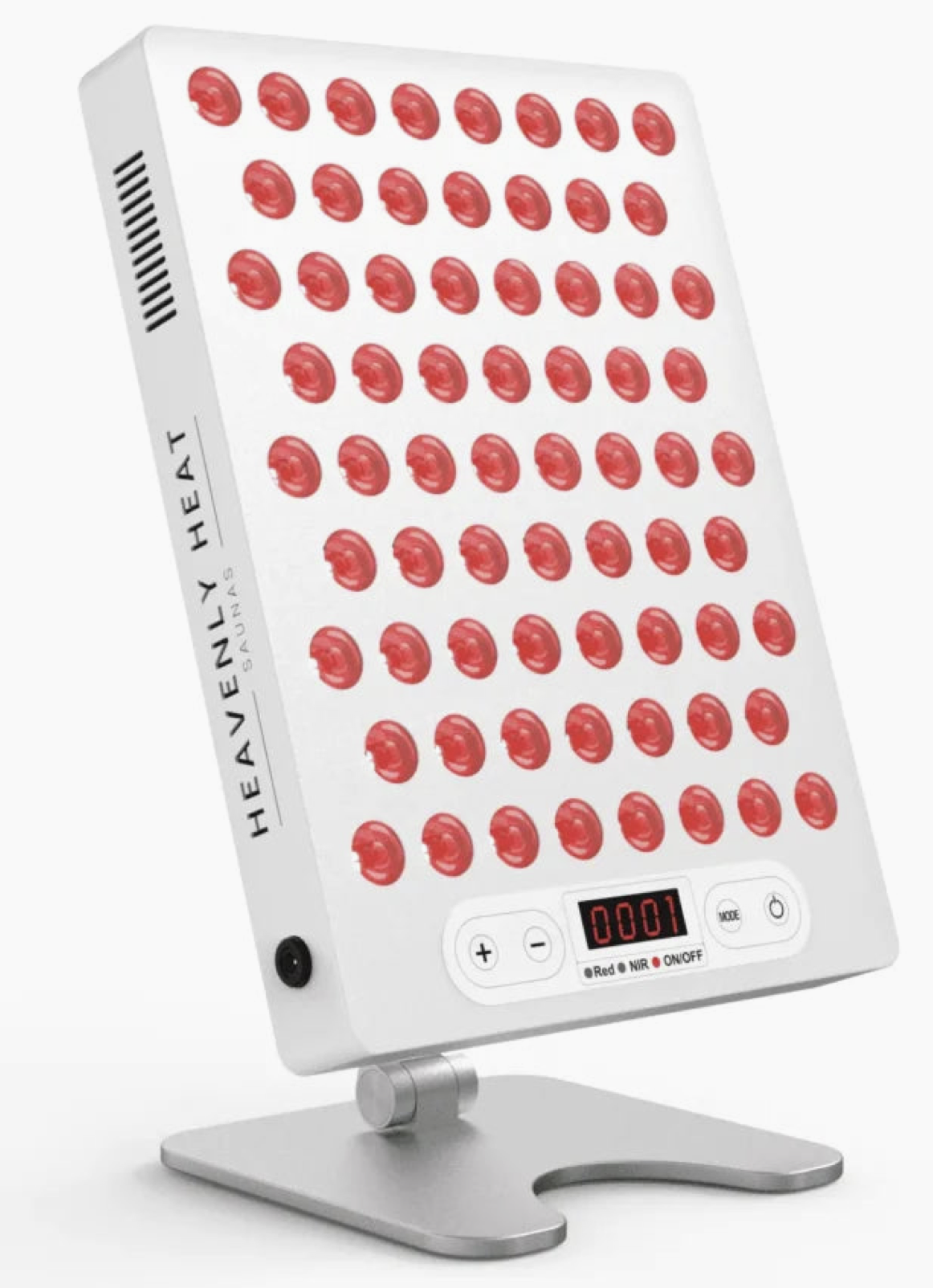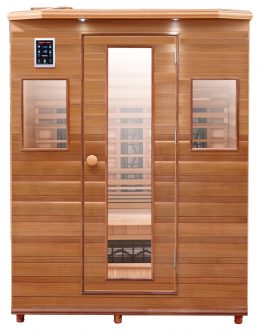
Red Light Saunas - Should You Buy One?
In recent years, red light saunas—also known as infrared saunas with red light therapy—have surged in popularity among wellness enthusiasts, athletes, and even dermatologists. Combining the therapeutic heat of traditional saunas with the cellular benefits of red and near-infrared (NIR) light, these saunas are touted for a wide array of potential health benefits—from skin rejuvenation to muscle recovery.
But how much of this is hype, and how much is grounded in science? Let's break it down.
What is a Red Light Sauna?
A red light sauna combines two therapies:
- Infrared Sauna Therapy: Uses infrared heaters to emit radiant heat that penetrates the skin, warming your body directly (as opposed to heating the air like a traditional sauna).
- Red Light Therapy (RLT): Emits low-level red (typically 620–750 nm) and near-infrared light (750–1200 nm) to stimulate cellular activity.
While infrared heat promotes sweating and detoxification, red and NIR light target the mitochondria—the powerhouses of your cells—to support healing, reduce inflammation, and improve skin health.
Red and near-infrared light stimulate a process called photobiomodulation (PBM), where light is absorbed by cytochrome c oxidase in the mitochondria. This process boosts ATP (adenosine triphosphate) production—your cells’ energy currency.
When cells have more energy, they can function more efficiently, repair damage faster, and reduce inflammation.
The U.S. National Library of Medicine explains photobiomodulation in this review on low-level light therapy, noting improved tissue repair, anti-inflammatory effects, and enhanced mitochondrial function.
What are the Key Benefits of Red Light Therapy?
1. Improved Skin Health and Anti-Aging
Red light therapy may stimulate collagen production, reduce fine lines and wrinkles, and help manage conditions like psoriasis or acne.
A double-blind, placebo-controlled trial found significant improvements in skin complexion and collagen density in participants who received red light therapy over 30 sessions.
2.Muscle Recovery and Reduced Inflammation
Athletes and fitness enthusiasts use red light saunas to speed up muscle recovery and reduce soreness after intense workouts. The heat and red/NIR light combo can improve circulation, reduce oxidative stress, and aid in cellular repair.
This systematic review in Lasers in Medical Science found red light therapy beneficial for reducing muscle soreness and improving performance when used pre- or post-exercise.
3.Pain Relief (Including Joint and Nerve Pain)
Red light therapy may relieve chronic pain, including arthritis, neuropathy, and muscle tension. The heat from the sauna further eases stiffness.
The VA (U.S. Department of Veterans Affairs) has investigated photobiomodulation therapy for chronic pain, with promising results for veterans dealing with long-term pain.
4.Detoxification and Circulation Boost
Though detox claims can be controversial, the infrared heat in red light saunas induces deep sweating, which may help remove heavy metals and environmental toxins. The combination of heat and light also increases blood flow, aiding the transport of nutrients and waste.
Sweating does remove some toxins like BPA and heavy metals, but the liver and kidneys remain your primary detox organs. See this NIH-backed review on the role of sweat in toxin elimination.
5.Mood, Sleep, and Stress Reduction
Spending time in a red light sauna may help balance cortisol levels, support melatonin production, and stimulate the parasympathetic nervous system, promoting relaxation and sleep.
A study published in Behavioral and Brain Functions found that near-infrared light therapy improved mood in patients with major depression.
Are There Any Risks or Downsides?
While red light saunas are generally considered safe and non-invasive, it’s important to understand that “safe” doesn’t always mean “risk-free.” Like any wellness tool, proper use and individual considerations matter. Here’s what you should keep in mind before starting:
1. Eye Safety and Light Exposure
Red and near-infrared light, especially at high intensities, can be irritating to the eyes, and prolonged direct exposure may cause discomfort or even temporary visual disturbances like spots or glare.
- Protective eyewear is highly recommended during sessions—especially if you're using a panel that shines light near your face.
- Some sauna units may use diffused or ambient light that's easier on the eyes, but safety glasses are still a good idea for longer sessions.
People with light sensitivity, migraines, or ocular conditions (like cataracts or macular degeneration) should consult an optometrist before using red light therapy near the eyes.
2. Overuse and Dose-Response Limits
Red light therapy follows the principle of biphasic dose response—meaning too much exposure can reduce benefits or even cause mild side effects.
- Sessions that are too long or too frequent may lead to fatigue, overstimulation, or headaches in some users.
- More is not always better. Most manufacturers recommend 10–20 minutes per area, no more than once or twice a day.
Excessive use won’t necessarily harm you, but it may lead to diminishing returns or unnecessary strain on your nervous system.
3. Heat Sensitivity and Health Conditions
If you're using a red light sauna that includes infrared heat, people with certain medical conditions should proceed with caution:
- Cardiovascular conditions (e.g., low blood pressure, arrhythmias, heart disease)
- Neurological conditions (e.g., multiple sclerosis, epilepsy)
- Autoimmune disorders with heat sensitivity
- Pregnancy (many doctors advise avoiding infrared heat unless cleared)
Excessive heat may exacerbate symptoms or cause discomfort. Always check with a healthcare provider if you have a chronic medical condition or are unsure about your tolerance for heat.
4. Medication and Photosensitivity
Some medications and supplements can cause photosensitivity—a heightened sensitivity to light that may result in rashes, skin irritation, or dizziness when exposed to red/NIR light.
These include:
- Certain antibiotics (e.g., tetracyclines)
- Retinoids (common in acne or anti-aging treatments)
- St. John’s Wort (a natural antidepressant)
- Chemotherapy drugs
- Some diuretics and antihistamines
If you're on any prescription or over-the-counter medication, it’s wise to review the label or speak to a doctor before beginning red light therapy.
5. Device Quality and EMF Exposure
Not all red light devices are created equally. Low-cost or unregulated panels may emit excessive levels of electromagnetic fields (EMFs) or flicker at unhealthy rates—both of which can potentially cause fatigue or neurological irritation in sensitive individuals.
When shopping:
- Look for certified low-EMF or “zero-EMF” models
- Avoid devices with poor heat dispersion or unshielded wiring
- Stick with brands that publish irradiance data and safety certifications
High-quality infrared saunas also include insulated electrical components to reduce risk and improve long-term safety.
6. Delayed Results and Unrealistic Expectations
One of the subtler risks of red light therapy is expecting too much, too quickly. While backed by real science, red light isn’t a miracle cure—and results are often gradual, requiring consistency over weeks or months.
Unrealistic expectations can lead to:
- Frustration and quitting before results develop
- Overuse, which can dull effectiveness
- Overspending on unnecessary devices or “hacks”
Think of red light therapy more like nutrition or exercise—it builds up benefits over time, not overnight.
Bottom Line on Risks
Red light therapy—especially in a sauna setting—is safe for most healthy adults when used properly. But it’s important to:
- Use protective eyewear
- Stick to recommended session lengths
- Monitor for reactions (especially if on medication)
- Talk to your doctor if you have pre-existing health concerns
When used mindfully and consistently, a red light sauna can be a powerful wellness tool with very few downsides—just be aware of your body’s responses and respect the science behind the dosage.
Red Light Buying Guide: What to Look For
Purchasing a red light sauna—or assembling one using a standalone panel—can be a worthwhile investment, but the wide range of options on the market can make it overwhelming. Here's how to navigate the decision.
Full Red Light Sauna Units
These are typically full-body cabins that include both infrared heaters and built-in red/NIR light panels. They’re ideal if you:
- Want a streamlined, plug-and-play wellness experience
- Have space for a dedicated sauna room or corner
- Prefer combining heat and light therapy in one session
- Want full-body exposure without repositioning
Look for models with:
- Low EMF certification (especially important in enclosed spaces)
- Full-spectrum infrared (far, mid, and near) if you want a broader heat profile
- Integrated red & NIR LEDs with adequate intensity (check irradiance ratings in mW/cm²)
- Adjustable settings for temperature and light independently
Some premium saunas even let you toggle red light therapy separately from the infrared heat, offering more session flexibility.
Standalone Red Light Panels
These are ideal if:
- You already have an infrared sauna and want to add red/NIR
- You have limited space or budget
- You want targeted treatments (e.g., on your face, joints, or back)
- You’re heat-sensitive and prefer a non-sauna environment
When shopping for a panel, consider:
- Wavelengths: Look for panels that offer 660 nm (red) and 850 nm (NIR), the two most clinically studied and effective wavelengths.
- Coverage Area: Full-body panels are best for general wellness, while smaller panels are fine for targeted use.
- Irradiance: Ensure the light intensity is strong enough to penetrate skin and muscle (typically >50 mW/cm² at 6–12 inches).
- Flicker & EMF: Cheaper panels may emit flicker or higher EMF—stick with tested, reputable brands.
Also, be aware that panels do not produce heat—you may want to combine them with a heating mat, sauna blanket, or portable sauna tent if warmth is a goal.
Our Experts' Top Red Light Saunas
BUILT-IN RED LIGHT SAUNAS
If you're looking for a sauna with red lights built in, check out Sunlighten's mPulse collection. These full spectrum infrared saunas have customizable red lights built right into the back wall.
CHECK OUT THE SUNLIGHT MPULSE COLLECTION HERE!
STAND ALONE PANELS
If you're looking for stand alone red light panels, check out Heavenly Heat. They have three different models to choose from: Heavenly Mid, Heavenly Pro & Heavenly Max.
CHECK OUT ALL THREE MODELS ON SALE HERE!
Final Thoughts: Is it Worth It?
For many people, a red light sauna delivers a powerful mix of science-backed benefits, relaxation, and ritual—all rolled into one. While the buzz around red light therapy can feel overwhelming at times, there’s real substance behind its growing popularity.
The Pros:
- Backed by a growing body of clinical and government-funded research
- Non-invasive and low-risk, with virtually no side effects
- Customizable: can be used as part of a heat therapy protocol or separately
- Fits many goals—skin health, pain relief, recovery, mood, detox, circulation, and more
The Considerations:
- Results are gradual—not instant. You’ll typically need consistent use over 4–8 weeks to see changes.
- Not all devices are created equal—buying a low-powered or poorly designed product can limit results.
- It’s not a silver bullet. RLT works best when combined with good sleep, hydration, movement, and nutrition.
- Budget can be a factor—quality sauna units and full-body panels can cost several hundred to several thousand dollars.
In short: if you're someone who values daily recovery, performance, and aging well without invasive treatments or drugs, a red light sauna can be a worthwhile and long-term wellness investment.
Need a Recommendation?
Need a recommendation?

Let our experts help you choose the perfect red light sauna!


